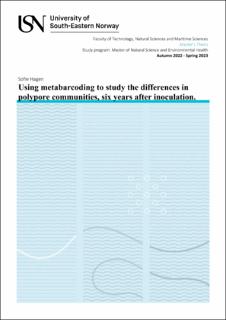| dc.description.abstract | The forests of Fennoscandia are essential habitats for polypores and wood-decaying fungi, but many rare polypores are experiencing declines due to habitat loss and fragmentation. DNA methods are enhancing our understanding of polypore ecology, providing valuable insights into their functional dynamics. This knowledge can greatly aid in polypore species conservation. In this study, polypores were monitored following the inoculation of Fomitopsis rosea, Phellopilus nigrolimitatus, and Amylocystis lapponica, carried out by Sundy Maurice in 2016. The 15 deadwood logs used for inoculation were situated in three Norway spruce (Picea abies) forests with different management histories: managed, semi-natural, and natural. This thesis studied the differences in polypore communities in these forests following inoculation, evaluated the effectiveness of metabarcoding in detecting rare polypore species, and explored the potential impacts of inoculation on community dynamics. The research was conducted with metabarcoding methods using tagged PCR techniques. A difference in community composition was observed between the managed forest and the other two sites, mainly due to the decay stages of the logs recorded in 2016. The semi-natural forest had the highest occurrence of red-listed species. The significance of the inoculations could not be tested due to the limited observations of the inoculated species, but potential interactions were seen in one deadwood log. There are few studies of this kind, and there is limited research on community assembly following inoculation. This study demonstrates the efficiency of metabarcoding in detecting community differences and rare species even when using a relatively small sample size. These findings emphasize the potential of metabarcoding as a powerful tool for ecological research and monitoring. | |
